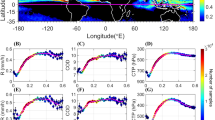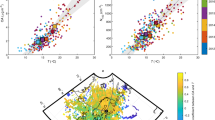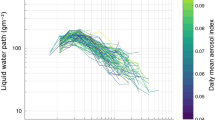Abstract
It is thought that changes in the concentration of cloud-active aerosol can alter the precipitation efficiency of clouds, thereby changing cloud amount and, hence, the radiative forcing of the climate system. Despite decades of research, it has proved frustratingly difficult to establish climatically meaningful relationships among the aerosol, clouds and precipitation. As a result, the climatic effect of the aerosol remains controversial. We propose that the difficulty in untangling relationships among the aerosol, clouds and precipitation reflects the inadequacy of existing tools and methodologies and a failure to account for processes that buffer cloud and precipitation responses to aerosol perturbations.
This is a preview of subscription content, access via your institution
Access options
Subscribe to this journal
Receive 51 print issues and online access
$199.00 per year
only $3.90 per issue
Buy this article
- Purchase on Springer Link
- Instant access to full article PDF
Prices may be subject to local taxes which are calculated during checkout




Similar content being viewed by others
References
Squires, P. The microstructure and colloidal stability of warm clouds. I. The relation between structure and stability. Tellus 10, 256–271 (1958)This paper shows that clouds that form in clean marine air are more apt to precipitate than clouds forming in air containing a high aerosol burden.
Liou, K.-N. & Ou, S.-C. The role of cloud microphysical processes in climate: an assessment from a one-dimensional perspective. J. Geophys. Res. 94, 8599–8607 (1989)
Albrecht, B. A. Aerosols, cloud microphysics and fractional cloudiness. Science 245, 1227–1230 (1989)This study postulates that by suppressing precipitation, the aerosol might increase cloud lifetime and thus enhance radiative forcing.
Pincus, R. & Baker, M. B. Effect of precipitation on the albedo susceptibility of clouds in the marine boundary layer. Nature 372, 250–252 (1994)
Hartmann, D. L. & Doelling, D. On the net radiative effectiveness of clouds. J. Geophys. Res. 96, 869–891 (1980)
Tiedtke, M. A comprehensive mass flux scheme for cumulus parameterization in large-scale models. Mon. Weath. Rev. 117, 1779–1800 (1989)
Bony, S. & Dufresne, J.-L. Marine boundary layer clouds at the heart of tropical cloud feedback uncertainties in climate models. Geophys. Res. Lett. 32, L20806 (2006)This paper shows that the sensitivity of shallow marine clouds to changing environmental conditions is the main source of uncertainty in tropical cloud feedbacks simulated by climate models.
Rosenfeld, D. et al. Flood or drought: how do aerosols affect precipitation? Science 321, 1309–1313 (2008)
Jiang, H., Xue, H., Teller, A., Feingold, G. & Levin, Z. Aerosol effects on the lifetime of shallow cumulus. Geophys. Res. Lett. 33 1029/2006GL026024 (2006)
Twomey, S. The influence of pollution on the shortwave albedo of clouds. J. Atmos. Sci. 34, 1149–1152 (1977)This was the first study to point out the potential for the aerosol to brighten clouds, leading to the concept of cloud-mediated (or indirect) aerosol effects.
Levin, Z. & Cotton, W. Aerosol Pollution Impact on Precipitation (Springer, 2008)This book provides a comprehensive review of aerosol effects on clouds and precipitation.
Storelvmo, T. et al. Modeling the Wegner-Bergeron-Findeisen process—implications for aerosol indirect effects. Environ. Res. Lett. 3, 045001 (2008)
Stevens, B. et al. Pockets of open cells and drizzle in marine stratocumulus. Bull. Am. Meteorol. Soc. 86, 51–57 (2005)
Radke, L. F., Coakley, J. A. & King, M. D. Direct and remote sensing observations of the effects of ships on clouds. J. Appl. Meteorol. 246, 1146–1149 (1989)
Comstock, K. K., Bretherton, C. S. & Yuter, S. E. Mesoscale variability and drizzle in southeast Pacific stratocumulus. J. Atmos. Sci. 62, 3792–3807 (2005)
Sharon, T. M. et al. Aerosol and cloud microphysical characteristics of rifts and gradients in maritime stratocumulus clouds. J. Atmos. Sci. 63, 983–997 (2006)
Stephens, G. et al. The CloudSat mission and the A-TRAIN: a new dimension to space-based observations of clouds and precipitation. Bull. Am. Meteorol. Soc. 83, 1771–1790 (2002)
Coakley, J. A., Bernstein, L. & Durkee, A. Effect of ship-stack effluents on cloud reflectivity. Science 237, 1020–1022 (1987)
Han, Q., Rossow, W. B. & Lacis, A. A. Near-global survey of effective droplet radii in liquid water clouds using ISCCP data. J. Clim. 7, 465–497 (1994)
Sekiguchi, M. et al. A study of the direct and indirect effects of aerosols using global satellite data sets of aerosol and cloud parameters. J. Geophys. Res. 108 10.1029/2002JD003359 (2003)
Loeb, N. G. & Schuster, G. L. An observational study of the relationship between cloud, aerosol and meteorology in broken low-level cloud conditions. J. Geophys. Res. 113, D14214 (2008)The introduction to this study provides a salient overview of many of the challenges of using satellite observations to relate clouds to the aerosol.
Kaufman, Y. J., Koren, I., Remer, L. A., Rosenfeld, D. & Rudich, Y. The effect of smoke, dust, and pollution aerosol on shallow cloud development over the Atlantic Ocean. Proc. Natl Acad. Sci. USA 102, 11207–11212 (2005)
Matheson, M. A., Coakley, J. A. & Tahnk, W. R. Aerosol and cloud property relationships for summertime stratiform clouds in the northeastern Atlantic from Advanced Very High Resolution Radiometer observations. J. Geophys. Res. 110, D24204 (2005)
Nakajima, T., Higurashi, A., Kawamoto, K. & Penner, J. E. A possible correlation between satellite-derived cloud and aerosol microphysical parameters. Geophys. Res. Lett. 28 10.1029/2000GL012186 (2001)
Rosenfeld, D. TRMM observed first direct evidence of smoke from forest fires inhibiting rainfall. Geophys. Res. Lett. 26, 3105–3108 (1999)
Andreae, M. O. et al. Smoking rain clouds over the Amazon. Science 303, 1337–1342 (2004)
Charlson, R., Ackerman, A., Bender, F.-M., Anderson, T. & Liu, Z. On the climate forcing consequences of the albedo continuum between cloudy and clear air. Tellus B 59 10.1111/j.1600–0889.2007.00297.x (2007)
Koren, I., Remer, L. A., Kaufman, Y. J., Rudich, Y. & Martins, J. V. On the twilight zone between clouds and aerosols. Geophys. Res. Lett. 34, L08805 (2007)
Anderson, J. B. Observations from airplanes of cloud and fog conditions along the southern Californian coast. Mon. Weath. Rev. 59, 264–270 (1931)
Várnai, T. & Marshak, A. MODIS observations of enhanced clear sky reflectance near clouds. Geophys. Res. Lett. 36, L06807 (2009)This study shows that three-dimensional radiative interactions between clouds and their surroundings extend up to 15 km beyond the boundaries of the clouds.
Avey, L., Garrett, T. J. & Stohl, A. Evaluation of the aerosol indirect effect using satellite, tracer transport model, and aircraft data from the International Consortium for Atmospheric Research on Transport and Transformation. J. Geophys. Res. 112 10.1029/2006JD007581 (2007)
Rauber, R. et al. Rain in (shallow) cumulus over the ocean–the RICO campaign. Bull. Am. Meteorol. Soc. 88, 1912–1928 (2007)
Nuijens, L., Stevens, B. & Siebesma, A. P. The environment of precipitating shallow cumulus convection. J. Atmos. Sci. 66, 1962–1969 (2009)
Arakawa, A. in The Physical Basis of Climate and Climate Modelling 181–197 (GARP Publ. Ser. 16, ICSU/WMO, 1975)This prescient study was perhaps the first to appreciate the singular problem clouds pose for the modelling of the general circulation of the atmosphere.
Stevens, B. & Brenguier, J.-L. in Clouds in the Perturbed Climate System: Their Relationship to Energy Balance, Atmospheric Dynamics and Precipitation (eds Heintzenberg, J. & Charlson, R. J.) Ch. 8 (MIT Press, 2009)
Brenguier, J. L., Pawlowska, H. & Schüller, L. J. Cloud microphysical and radiative properties for parameterization and satellite monitoring of the indirect effect of aerosol on climate. J. Geophys. Res. 108 10.1029/2002JD002682 (2003)
Mauger, G. S. & Norris, J. R. Meteorological bias in satellite estimates of aerosol-cloud relationships. Geophys. Res. Lett. 34 10.1029/2007GL029952 (2007)
Hoppel, W. A., Fitzgerald, J. W., Frick, G. M., Larson, R. E. & Mack, E. J. Aerosol size distributions and optical properties found in the marine boundary layer over the Atlantic Ocean. J. Geophys. Res. 95, 3659–3686 (1990)
Hegg, D., Majeed, R., Yuen, P., Baker, M. & Larson, T. The impacts of SO2 oxidation in cloud drops and in haze particles on aerosol light scattering and CCN activity. Geophys. Res. Lett. 23, 2613–2616 (1996)
Boucher, O. & Lohmann, U. The sulfate-CCN-cloud albedo effect: a sensitivity study with two general circulation models. Tellus B 47, 281–300 (1995)
Hoose, C., Kristjánsson, J. E., Kirkevåg, A., Seland, Ø. & Gettelman, A. Constraining cloud drop number concentration in GCMs suppresses the aerosol indirect effect. Geophys. Res. Lett. 36 10.1029/2009GL038568 (2009)
Lohmann, U. & Feichter, J. Global indirect aerosol effects: a review. Atmos. Chem. Phys. 5, 715–737 (2005)This paper provides a comprehensive overview of aerosol–cloud interactions (indirect effects) in global climate models and suggest required improvements.
Quaas, J. et al. Aerosol indirect effects — general circulation model intercomparison and evaluation with satellite data. Atmos. Chem. Phys. Discuss. 9, 12731–12779 (2009)
Murphy, D. M. et al. An observationally based energy balance for the Earth since 1950. J. Geophys. Res. (in the press)
Knutti, R., Stocker, T. F., Joos, F. & Plattner, G.-K. Constraints on radiative forcing and future climate change from observations and climate model ensembles. Nature 416, 719–723 (2002)
Rotstayn, L. D. Indirect forcing by anthropogenic aerosols: a global climate model calculation of the effective-radius and cloud-lifetime effects. J. Geophys. Res. 104, 9369–9380 (1999)
Lohmann, U. & Feichter, J. Impact of sulfate aerosols on albedo and lifetime of clouds: a sensitivity study with the ECHAM GCM. J. Geophys. Res. 102, 13685–13700 (1997)
Feingold, G. & Siebert, H. in Clouds in the Perturbed Climate System: Their Relationship to Energy Balance, Atmospheric Dynamics and Precipitation, (eds Heintzenberg, J. & Charlson, R. J.) Ch. 14 (MIT Press, 2009)
Twomey, S. A. The nuclei of natural cloud formation, part II: the supersaturation in natural clouds and the variation of cloud droplet concentration. Pure Appl. Geophys. 43, 243–249 (1959)
Martin, G. M., Johnson, D. & Spice, A. The measurement and parameterization of effective radius of droplets in warm stratocumulus clouds. J. Atmos. Sci. 51, 1823–1842 (1994)
O’Dowd, C. D., Lowe, J. A., Smith, M. H. & Kaye, A. D. The relative importance of non-sea sulphate and sea-salt aerosol to the marine cloud condensation nuclei population: an improved multi-component aerosol-cloud droplet parameterization. Q. J. R. Meteorol. Soc. 125, 1295–1313 (1999)
Ramanathan, V., Crutzen, P., Kiehl, J. & Rosenfeld, D. Aerosols, climate and the hydrological cycle. Science 294, 2119–2124 (2001)
Johnson, D. B. The role of giant and ultragiant aerosol particles in warm rain initiation. J. Atmos. Sci. 39, 448–460 (1982)
Seifert, A. & Beheng, K. D. A double-moment parameterization for simulating autoconversion, accretion and self collection. Atmos. Res. 59–60, 265–281 (2001)
Pawlowska, H. & Brenguier, J.-L. An observational study of drizzle formation in stratocumulus clouds for general circulation model (GCM) parameterization. J. Geophys. Res. 33, L19810 (2003)
Comstock, K. K., Wood, R., Yuter, S. E. & Bretherton, C. S. Reflectivity and rain rate in and below drizzling stratocumulus. Q. J. R. Meteorol. Soc. 130, 2891–2918 (2004)
vanZanten, M., Stevens, B., Vali, G. & Lenschow, D. Observations of drizzle in nocturnal marine stratocumulus. J. Atmos. Sci. 62, 88–106 (2005)
Petters, M. D. et al. Accumulation mode aerosol, pockets of open cells and particle nucleation in the remote subtropical pacific marine boundary layer. J. Geophys. Res. 111, D02206 (2005)
Sorooshian, A., Feingold, G., Lebsock, M. D., Jiang, H. & Stephens, G. L. On the precipitation susceptibility of clouds to aerosol perturbations. Geophys. Res. Lett. 36, 10.1029/2009GL038993 (2009)
Wood, R. Rate of loss of cloud droplets by coalescence in warm clouds. J. Geophys. Res. 111, D21205 (2006)
Stevens, B. & Seifert, A. Understanding the macrophysical outcomes of microphysical choices in simulations of shallow cumulus convection. J. Meteorol. Soc. Jpn 86A, 141–163 (2008)
Ayala, O., Rosa, B., Wang, L.-P. & Grabowski, W. Effects of turbulence on the geometric collision rate of sedimenting droplets. Part 1. Results from direct numerical simulation. N. J. Phys. 10, 075015 (2008)
Stevens, B., Cotton, W. R., Feingold, G. & Moeng, C.-H. Large-eddy simulations of strongly precipitating, shallow, stratocumulus-topped boundary layers. J. Atmos. Sci. 55, 3616–3638 (1998)
Ackerman, A. S., Kirkpatrick, M. P., Stevens, D. E. & Toon, O. B. The impact of humidity above stratiform clouds on indirect aerosol climate forcing. Nature 432, 1014–1017 (2004)
Bretherton, C., Blossey, P. & Uchida, J. Cloud droplet sedimentation, entrainment efficiency and subtropical stratocumulus albedo. Geophys. Res. Lett. 34 10.1029/2006GL027648 (2007)
Stevens, B. On the growth of layers of non-precipitating cumulus convection. J. Atmos. Sci. 64, 2916–2931 (2007)
Wood, R. Cancellation of aerosol indirect effects in marine stratocumulus through cloud thinning. J. Atmos. Sci. 64, 2657–2669 (2007)
Koren, I., Kaufman, Y. J., Rosenfeld, D., Remer, L. A. & Rudich, Y. Aerosol invigoration and restructuring of Atlantic convective clouds. Geophys. Res. Lett. 32, L14828 (2005)
Tao, W.-K. Cloud resolving modeling. J. Meteorol. Soc. Jpn 85B, 305–330 (2007)
Khain, A. P., BenMoshe, N. & Pokrovsky, A. Factors determining the impact of aerosols on surface precipitation from clouds: an attempt at classification. J. Atmos. Sci. 65, 1721–1748 (2008)
Kay, J. E. & Wood, R. Timescale analysis of aerosol sensitivity during homogeneous freezing and implications for upper tropospheric water vapor budgets. Geophys. Res. Lett. 35, L10809 (2008)
Lee, S. S., Donner, L. J., Phillips, V. T. J. & Ming, Y. Examination of aerosol effects on precipitation in deep convective clouds during the 1997 ARM summer experiment. Q. J. R. Meteorol. Soc. 134, 1201–1220 (2008)
Feingold, G., Stevens, B., Cotton, W. R. & Frisch, A. S. On the relationship between drop in-cloud residence time and drizzle production in stratocumulus clouds. J. Atmos. Sci. 53, 1108–1122 (1996)
Wang, S., Wang, Q. & Feingold, G. Turbulence, condensation and liquid water transport in numerically simulated nonprecipitating stratocumulus clouds. J. Atmos. Sci. 60, 262–278 (2003)
Small, J. D., Chuang, P. Y., Feingold, G. & Jiang, H. Can aerosol increase cloud lifetime? Geophys. Res. Lett. (in the press)
Lu, M.-L. & Seinfeld, J. Study of the aerosol indirect effect by large-eddy simulation of marine stratocumulus. J. Atmos. Sci. 62, 3909–3932 (2005)
Sandu, I., Brenguier, J.-L. & Geoffroy, O. Aerosol impacts on the diurnal cycle of marine stratocumulus. J. Atmos. Sci. 65, 2705–2718 (2008)
Han, Q., Rossow, W. B., Zeng, J. & Welch, R. Three different behaviors of liquid water path of water clouds in aerosol-cloud interactions. J. Atmos. Sci. 59, 726–735 (2002)
Matsui, T. et al. Satellite-based assessment of marine low-cloud variability associated with aerosol, atmospheric stability and the diurnal cycle. J. Geophys. Res. 111 10.1029/2005JD006097 (2006)
Houze, R. Mesoscale convective systems. Rev. Geophys. 42 10.1029/2004RG000150 (2004)
Xue, H., Feingold, G. & Stevens, B. Aerosol effects on clouds, precipitation, and the organization of shallow cumulus convection. J. Atmos. Sci. 65, 392–406 (2008)
Xue, H. & Feingold, G. Large eddy simulations of tradewind cumuli: investigation of aerosol indirect effects. J. Atmos. Sci. 63, 1605–1622 (2006)
Ackerman, A. S. et al. Reduction of tropical cloudiness by soot. Science 288, 1042–1047 (2000)
Koren, I., Kaufman, Y. J., Remer, L. A. & Martins, J. V. Measurement of the effect of Amazon smoke on inhibition of cloud formation. Science 303, 1342–1345 (2004)
Feingold, G., Jiang, H. & Harrington, J. Y. On smoke suppression of clouds in Amazonia. Geophys. Res. Lett. 32 10.1029/2004GL021369 (2005)
Lau, K.-M., Kim, M.-K. & Kim, K.-M. Asian summer monsoon anomalies induced by aerosol direct forcing: the role of the Tibetan Plateau. Clim. Dyn. 26, 855–864 (2006)
Baker, M. & Charlson, R. J. Bistability of CCN concentrations and thermodynamics in the cloud-topped boundary layer. Nature 345, 142–145 (1990)This paper postulated the existence of two stable states for shallow clouds that have since been verified by observation.
Latham, J. et al. Global temperature stabilization via controlled albedo enhancement of low-level maritime clouds. Phil. Trans. R. Soc. A 366, 3969–3987 (2008)
Heliere, A., Lefebvre, A., Wehr, T., Bezy, J.-L. & Durand, Y. in Proc. Geosci. Remote Sensing Symp. 2007 4975–4978 (IEEE, 2007)
Henson, R. Satellite Observations to Benefit Science and Society: Recommended Missions for the Next Decade Committee on Earth Science and Applications from Space: A Community Assessment and Strategy for the Future 10 (US National Academies Press, 2008)
Jamison, L., Sommer, G. & Porche, I. R. High-Altitude Airships for the Future Force Army. Tech. Report TR-234 (RAND Corporation, 2005)
Wood, R., Mechoso, C., Bretherton, C., Huebert, B. & Weller, R. The VAMOS ocean-cloud-atmosphere-land study (VOCAL). U.S. CLIVAR Var. 5, 1–5 (2007)
McComiskey, A. M. et al. An assessment of aerosol-cloud interactions in marine stratus clouds based on surface remote sensing. J. Geophys. Res. 114 10.1029/2008JD011006 (2009)
Acknowledgements
We thank M. O. Andreae, T. Garrett, J. Marotzke, L. Nuijens, R. Pincus, I. Sandu, A. Seifert and R. Wood for comments on an earlier draft of this manuscript. We also wish to acknowledge contributions to this document arising through the course of many discussions with members of the Aerosol, Clouds, Precipitation and Climate Initiative planning team.
Author Contributions The ideas presented here were developed jointly by B.S. and G.F., and both authors participated actively in the writing of the manuscript and the drafting of the figures.
Author information
Authors and Affiliations
Corresponding author
Rights and permissions
About this article
Cite this article
Stevens, B., Feingold, G. Untangling aerosol effects on clouds and precipitation in a buffered system. Nature 461, 607–613 (2009). https://doi.org/10.1038/nature08281
Issue Date:
DOI: https://doi.org/10.1038/nature08281
This article is cited by
-
The implication of atmospheric aerosols on rainfall over Malawi, Southeast Africa
Climatic Change (2024)
-
Nonlinearity of the cloud response postpones climate penalty of mitigating air pollution in polluted regions
Nature Climate Change (2023)
-
Local surface cooling from afforestation amplified by lower aerosol pollution
Nature Geoscience (2023)
-
Radiative forcing from aerosol–cloud interactions enhanced by large-scale circulation adjustments
Nature Geoscience (2023)
-
On the Nature of Caspian Clouds
Journal of Meteorological Research (2023)
Comments
By submitting a comment you agree to abide by our Terms and Community Guidelines. If you find something abusive or that does not comply with our terms or guidelines please flag it as inappropriate.



